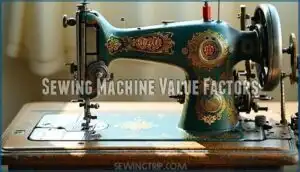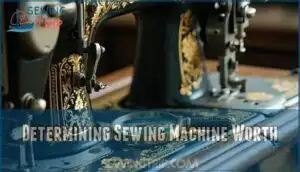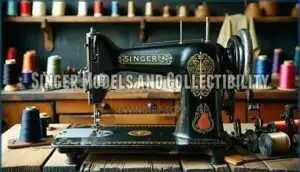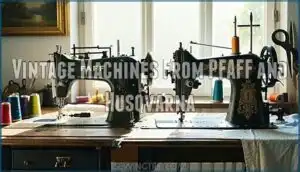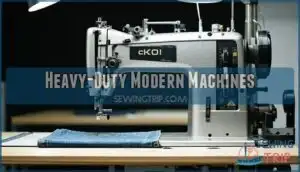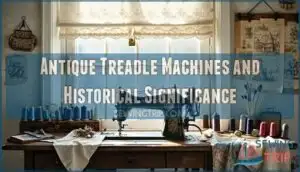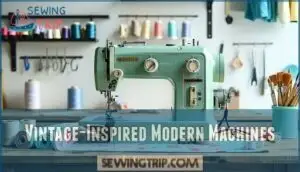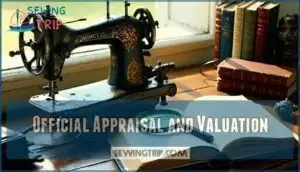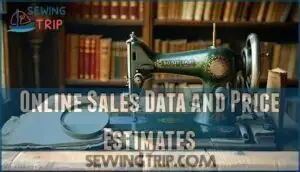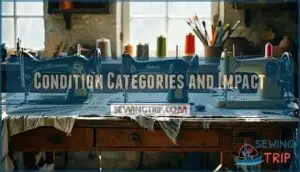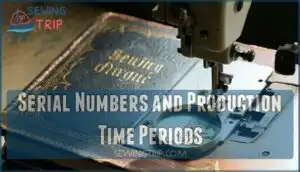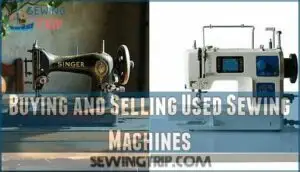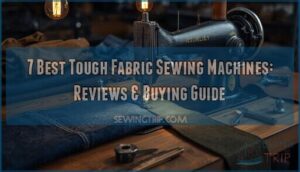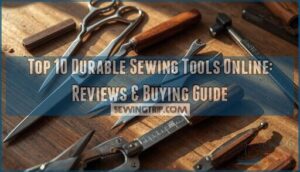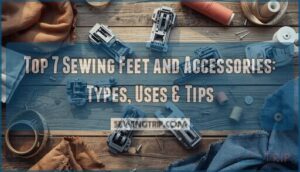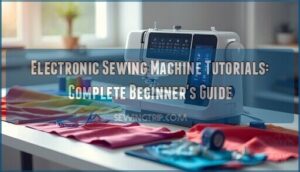This site is supported by our readers. We may earn a commission, at no cost to you, if you purchase through links.
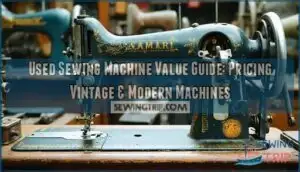
Brand reputation matters—Singer, Bernina, and Pfaff typically retain higher values.
Age can work both ways: vintage machines in good condition may fetch premium prices, while outdated computerized models often don’t.
Condition is vital—working machines with original parts command more than those needing repairs.
Complete accessories, original manuals, and cases add substantial value.
Check serial numbers online and compare prices on eBay, Etsy, and Facebook Marketplace for similar models that have actually sold.
Sometimes, that rusty machine gathering dust might be worth more than you’d think.
Table Of Contents
Key Takeaways
- Your machine’s brand matters significantly—Singer, Bernina, and Pfaff typically retain higher values due to their reputation for quality and collectibility.
- You’ll need to consider both age and condition when valuing your sewing machine—vintage models in excellent condition can fetch premium prices, while machines needing repairs will see their value drop substantially.
- Don’t overlook the importance of original accessories, manuals, and cases—these components can dramatically increase your machine’s worth to collectors and practical users alike.
- You can determine your machine’s value by researching serial numbers online and comparing prices of similar models that have actually sold on platforms like eBay, Etsy, and Facebook Marketplace.
Sewing Machine Value Factors
When figuring out a sewing machine’s value, you’ll need to focus on key features like the brand, age, and condition.
Rare models and market trends also play a big role, so it’s worth paying attention to what collectors and crafters want, considering the condition of the machine.
Brand and Model Impact
In the context of sewing machine value, the brand and model can make or break the price.
Some top sewing machine brands include:
- Singer Featherweight: A legend in collectibility.
- PFAFF Value: Known for precision and longevity.
- Husqvarna Collectibles: Beloved for unique designs.
- Model Rarity: Limited editions always fetch more.
A strong brand reputation equals lasting value.
Age and Condition Effects
The sewing machine’s age doesn’t always guarantee higher value—it depends on its condition.
An antique sewing machine in mint shape outshines a vintage one with functional damage.
Modern wear and missing parts lower worth, but careful restoration can help.
Always weigh restoration costs against the machine’s potential price to guide Antique Valuation decisions and appreciate true sewing machine condition.
Rarity and Unique Features
Unique features make a huge difference in value.
Limited editions, custom engravings, and low serial numbers often signal rarity and boost appeal to collectors.
Early models with historical significance can fetch a premium, especially when they’re part of a collectible sewing machine lineup.
The Singer 221 Featherweight, known for its portability, is a prime example of a sought-after model.
Joining a sewing machine collectors society could help you spot an antique sewing machine’s hidden worth.
Market Demand and Trends
Ever wonder how market demand shapes sewing machine prices?
Collector preferences and crafting popularity drive sewing machine value trends. Vibrant sewing communities and shifting economic factors impact what people are willing to pay.
Rising material costs can elevate sewing machine values, too. The sewing machine market thrives on what’s trending, making prices fluctuate faster than fabric on a running stitch.
The overall market dynamics are influenced by various factors, including collector preferences and the popularity of crafting, which in turn affect the sewing machine prices.
Functional Foot Pedals and Cases
A well-functioning foot pedal and sturdy case can truly sew up your machine’s value.
I’ll create a short, engaging blockquote in the same tone as the content about sewing machine foot pedals and cases.
A reliable foot pedal and original case aren’t just accessories—they’re value multipliers for any serious machine collector.
The pedal guarantees smooth operation, while the case protects the machine. Many retailers sell replacement sewing pedals.
Key factors:
- Foot Pedal Functionality: Essential for usability.
- Case Material Quality: Durable materials last longer.
- Pedal Repair Costs: Expensive fixes reduce value.
- Case Protection Level: Minimizes damage.
- Pedal Compatibility Issues: Mismatched parts decrease worth.
Determining Sewing Machine Worth
Figuring out your sewing machine’s worth involves checking key details like the serial number, model, and condition.
With a little research and guidance, you can uncover its true value and even spot hidden gems.
Locating Serial and Model Numbers
To identify your sewing machine, start with serial location tips—check the base, neck, or data plate types for hidden serial spots.
A model number guide helps decode sewing machine models like Singer.
Serial numbers often reveal production dates and versions.
Don’t overlook engraved numbers on older machines or under transport covers.
Machine condition impacts value substantially, so assess it carefully.
Each number’s significance matters, and understanding the serial location and model number is crucial.
Researching Online Marketplaces
Start your online research by exploring eBay Comparisons and Etsy Valuations to understand prices.
Explore completed sales for trends, using Auction Insights and Classified Research for context. Facebook Marketplace offers a casual option to spot deals or gauge demand.
Marketplace Trends reveal what sells, so bookmark frequently. Online platforms make pricing easier—just beware of overhyped listings, and remember to use Auction Insights and Classified Research for a more accurate understanding.
Consulting Local Experts and Dealers
Visiting local experts, like sewing machine dealers, antique stores, or pawn shops, provides hands-on valuation help.
They offer dealer expertise, repair insights, and authentication services.
Appraisal costs vary, but you’ll gain valuable details about worth and condition, and practice negotiation tips.
A professional opinion often beats guessing—especially for delicate or rare machines!
Deciding on Sales Platforms
Choosing where to sell can feel like a sewing dilemma—so many threads, one needle.
Online marketplaces like Etsy vs. eBay each offer perks; Etsy is ideal for vintage, while eBay suits auctions.
Craigslist? Great for local gems.
Consignment options and antique dealers handle the work but take a cut.
Donation considerations? Sometimes sentimental value weaves deeper than dollars.
Sewing Machine Types and Values
In the context of sewing machines, their value often depends on the type, age, and specific features.
From sturdy antique treadle models to modern heavy-duty machines, each type has its own appeal and price range.
Singer Models and Collectibility
Singer sewing machines are legendary for reliability and charm.
Featherweight values stand out, especially the Model 221, with collectors loving its portability. Red Eye decals add flair, while Blackside models, made during WWII, reflect history.
Model variations, like the Turtleback, appeal due to uniqueness, boosting the desirability of Singer models. Check Singer serial numbers to gauge age and rarity.
Vintage Machines From PFAFF and Husqvarna
Vintage PFAFF and Husqvarna Viking machines are beloved for their craftsmanship and innovation.
PFAFF boasts features like precision stitching and IDT technology, while Husqvarna shines with intricate decals and unique mechanisms.
Collectible models often stand out due to their durability and charm.
When considering sewing machine value, focus on:
- Rarity
- Functionality
- Brand Comparison
- Sewing machine appraisal
- Overall condition
Heavy-Duty Modern Machines
Heavy-duty modern sewing machines are workhorses, perfect for sewing denim, leather, or other thick fabrics.
Look for motor power, stitch quality, and digital capabilities for the best results.
Durability testing guarantees these machines withstand frequent use, increasing resale value. Checking modern sewing machine values can help determine a fair price.
Features like speed reducers or free-arm designs make them versatile, and they’re favorites for their stamina and precision.
Antique Treadle Machines and Historical Significance
Antique treadle machines, with their intricate treadle mechanics and ornate cabinetry styles, take you straight into sewing machine history. These mechanical marvels weren’t just functional; they revolutionized homes and industries during their time.
Whether you’re enchanted by their craftsmanship or their historical context, their value lies in:
- Unique manufacturing features and craftsmanship.
- Historical value from iconic models, like Singer treadle machines.
- Potential for antique restoration projects.
Many collectors value these machines for their manual operation, which is a key aspect of their historical value.
Vintage-Inspired Modern Machines
Moving from antique treadle machines to vintage-inspired modern designs, you’ll find a mix of modern aesthetics and classic functionality.
These machines embrace vintage-inspired design while offering modern features, perfect for hybrid repair projects.
Their collectible potential depends on user experience and sewing machine value, often, a vintage sewing machine look paired with modern performance justifies a higher sewing machine price due to its modern performance.
Appraising and Pricing Sewing Machines
Figuring out how much a sewing machine is worth doesn’t have to be overwhelming.
With the right tools and a bit of research, you can confidently assess its value and understand what makes it stand out.
Official Appraisal and Valuation
How do you truly know your sewing machine’s worth?
Hiring an appraiser with solid qualifications guarantees accurate value determination.
Expect to pay a fee for sewing machine appraisal services, but it’s well worth it for insurance valuation or legal documentation.
A professional can evaluate value factors and provide expert testimony, simplifying the sewing machine appraisal process.
Online Sales Data and Price Estimates
Checking eBay sold data or Etsy pricing trends can give you a snapshot of what’s realistic.
Completed sales from online marketplaces, like RubyLane estimates or Catawiki Auctions, often reveal true values.
Use online databases for reliable auction price comparisons.
Analyzing these sites provides an online market analysis, helping you price competitively without undervaluing your machine, which is crucial for a competitive edge.
Condition Categories and Impact
Evaluating your machine’s condition is the ultimate price determiner in the sewing machine market.
You’ll find values categorized from Excellent Condition (near-perfect, fully functional) to Fair Condition (usable with minor issues) and Poor Condition (significant damage).
Restoration costs directly impact what buyers will pay, while functional impact outweighs cosmetic damage.
Remember, a working Singer with scratches will fetch more than a pristine-looking non-functional one.
Historical or Rare Machines and Notable Owners
Driven by their storied past, historical and rare sewing machines often fetch premium prices.
If your machine was owned by a notable figure or inventor like Singer himself, you’ll find it substantially more valuable. Early models with unique innovations or limited production runs can be worth thousands rather than hundreds.
When appraising an antique sewing machine, this historical significance and rarity factor might turn your attic find into a collectible treasure.
Some historical machines were designed with complex mechanical movements, similar to automatons.
Serial Numbers and Production Time Periods
The humble serial number on your sewing machine is actually a time-traveling key that reveals its historical value.
Serial numbers reveal vital dating information that directly impacts worth.
Here’s what they tell you:
- Manufacturing date and factory location
- Production volume during specific periods
- Rarity indicators for limited runs
- Model authentication to prevent counterfeit purchases.
Singer’s manufacturing history is particularly well-documented, with detailed model timelines available online, making it easier to determine the historical value and authenticity of a sewing machine, which can be a crucial factor in preventing counterfeit purchases.
Buying and Selling Used Sewing Machines
You’ll find both treasures and duds in the used sewing machine market, but with the right knowledge, you can confidently buy or sell these mechanical workhorses at fair prices.
Whether you’re hunting for a vintage Singer at an estate sale or listing your trusty PFAFF online, understanding machine values helps you avoid overpaying or underpricing these practical pieces of crafting history.
Finding Buyers and Sellers
Now that you’ve learned how to appraise your machine, you’ll need to connect with the right people.
Where are serious sewing machine enthusiasts hiding? You’ll find buyers and sellers across multiple channels.
Try online marketplaces like eBay and Craigslist, or connect with collector communities through forums.
Local advertising works well for nearby buyers.
Consider consignment options through an antique dealer or online antique malls to reach specialized audiences without handling the sale yourself, and explore online marketplaces for broader reach.
Estate Sales and Auctions
After finding potential buyers for your sewing machine, you might want to explore estate sales and auctions as treasure troves for both buying and selling these mechanical gems.
- You’ll often spot seasoned collectors clutching antique sewing machine appraisal guides at auctions
- Estate inventory frequently includes untouched machines stored in attics for decades
- Auctioneers with expertise in vintage machines can provide reliable auction values on the spot
- Bidding strategies differ between online and in-person auctions – always set your maximum price beforehand
- Antique fairs typically feature specialized appraisers who can authenticate rare models
Online Marketplaces and Classified Ads
While estate sales offer in-person inspection, online marketplaces open your sewing machine to a global audience.
eBay remains the gold standard, with completed sales providing realistic value benchmarks.
Etsy vs eBay depends on your machine’s age—vintage thrives on Etsy, while eBay works for all types.
Local classifieds eliminate shipping challenges but limit your buyer pool.
For listing optimization, sharp photos and detailed descriptions directly impact your selling price when negotiating online.
Pricing Strategies and Negotiation
Everyone wants to get the best deal when pricing and negotiating for used sewing machines.
Setting realistic expectations based on thorough market research is your first step to success.
- Research similar machines on eBay and Etsy to establish a price range chart before listing
- Consider buyer psychology—highlight unique features that justify your selling price
- Be prepared for negotiation tactics with a 10-15% buffer in your initial asking price
- Document machine condition thoroughly to support your value justification during discussions
When buying on eBay, be sure to check the seller’s detailed ratings before bidding to ensure a smooth transaction and get the best used sewing machine.
Ensuring Accurate Listings and Photos
For successful sewing machine sales, your photos and descriptions must tell the complete story.
Clear photography and detailed descriptions build trust with potential buyers.
| Photography Tips | Description Must-Haves |
|---|---|
| Multiple angles showing all sides | Model identification and serial number |
| Close-ups of any damage or wear | Honest representation of condition (1-10) |
| Well-lit images highlighting features | List of included accessories and manuals |
Don’t hide flaws—they’re part of the machine’s character and history.
You can find various models available when looking at used options.
Frequently Asked Questions (FAQs)
How can I find out how much my sewing machine is worth?
To determine your sewing machine’s worth, check the serial number.
Research similar models online on eBay or ISMACS, compare completed sales.
Consider consulting local experts at antique shops or sewing dealers to get a more accurate estimate of your sewing machine’s worth.
How do I get my sewing machine appraised?
Contact local sewing machine dealers, antique appraisers, or auction houses for professional evaluation.
You’ll need your machine’s model, serial number, and clear photos.
Online forums and collector groups can also provide informal assessments, and may help you find a professional evaluation.
Does anyone take old sewing machines?
Yes, many places take old sewing machines.
Nearly 70% of vintage machines find new homes through specialized collectors, craft shops, restoration enthusiasts, charity organizations, and online marketplaces like eBay or Facebook Marketplace.
This process allows for the restoration of old machines, giving them a new purpose.
How old does a sewing machine have to be to be considered an antique?
For a sewing machine to be considered truly antique, it needs to be over 100 years old.
Machines between 20-100 years old are classified as vintage, while anything newer is simply modern.
How to insure valuable sewing machines?
You’ll need specialized collectibles insurance for valuable machines.
Document each with photos, appraisals, and receipts.
Many homeowners’ policies won’t fully cover them without adding a personal articles floater for complete protection.
Can trade-ins affect machine value?
Trade-ins typically reduce your machine’s value by 30-50% when dealing with dealers. You’ll get more by selling privately, but trade-ins offer convenience and immediate credit toward your new purchase.
Are parts for discontinued models available?
Like treasures in a forgotten chest, parts for discontinued models can often be found through specialty suppliers, online marketplaces, and sewing communities.
You’ll typically pay premium prices for these increasingly rare components.
Do converted machines retain value?
Converted machines typically retain 50-70% of their original value.
You’ll find collectors often appreciate thoughtful modifications that preserve functionality while enhancing usability, especially when original parts are included with the sale, which can help retain more of the machine’s original value.
Which international models are most valuable?
German PFAFF and Swedish Husqvarna Viking machines command premium prices internationally.
You’ll also find Japanese-made Janome and Brother models from the 1950s-70s fetch high values, especially those with unique decals or mechanisms.
Conclusion
Ready to explore the realm of used sewing machine values? Whether you’ve inherited grandma’s vintage Singer or spotted a dusty Bernina at a garage sale, knowing your machine’s worth is empowering.
By considering brand reputation, condition, accessories, and market trends highlighted in this used sewing machine value guide, you’ll make informed decisions when buying or selling.
Remember, proper research takes time, but it’s worth every minute—just like that perfectly restored machine waiting for its next creative adventure.
- https://www.mearto.com/categories/singer-sewing-machines
- https://www.singer.com/pages/sewing-machine-value-what-is-your-sewing-machine-worth?srsltid=AfmBOoqcPgfbaJlDQHVSXyHMb6gUCojpZJEosf85JmvmMJSeJN1G8hPa
- https://ismacs.net/sewing_machine_articles/how_much_is_my_sewing_machine_worth.html
- https://www.chatterboxquilts.com/pricing
- https://www.aurorasewingcenter.com/collections/pre-loved-machines?srsltid=AfmBOorC1n0Y7P-lnpViKkNNA5PhfU2Q8MJYU_-U_Ud3px2r7SQO_UUF

